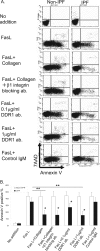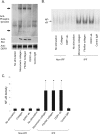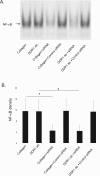Discoidin domain receptor 1 contributes to the survival of lung fibroblast in idiopathic pulmonary fibrosis
- PMID: 16507902
- PMCID: PMC1606536
- DOI: 10.2353/ajpath.2006.050801
Discoidin domain receptor 1 contributes to the survival of lung fibroblast in idiopathic pulmonary fibrosis
Retraction in
-
Retraction.Am J Pathol. 2007 Nov;171(5):1728. doi: 10.2353/ajpath.2007.070880. Am J Pathol. 2007. PMID: 17982135 Free PMC article. No abstract available.
Abstract
Idiopathic pulmonary fibrosis (IPF), characterized by fibroblast proliferation and accumulation of extracellular matrix, including collagen, is a chronic progressive disorder that results in lung remodeling and fibrosis. However, the cellular mechanisms that may make fibroblasts resistant to apoptosis have not been completely elucidated. Discoidin domain receptor 1 (DDR1), a receptor tyrosine kinase whose ligand is collagen, is expressed in vivo and contributes in vitro to leukocyte differentiation and nuclear factor (NF)-kappaB activation, which may play an important role in fibroblast survival. In this study, we examined in vivo and in vitro DDR1 expression and its role in cell survival using fibroblasts obtained from IPF and non-IPF patients. Immunohistochemically, fibroblasts present in fibroblastic foci expressed endogenous DDR1. The DDR1 expression level was significantly higher in fibroblasts from IPF patients, and the predominant isoform was DDR1b. In IPF patients, DDR1 activation in fibroblasts inhibited Fas ligand-induced apoptosis and resulted in NF-kappaB nuclear translocation. Suppression of DDR1 expression in fibroblasts by siRNA abolished these effects, and an NF-kappaB inhibitor abrogated the anti-apoptotic effect of DDR1 activation. We propose that DDR1 contributes to fibroblast survival in the tissue microenvironment of IPF and that DDR1 up-regulation may occur in other fibroproliferative lung diseases as well.
Figures








References
-
- Katzenstein AL, Myers JL. Idiopathic pulmonary fibrosis: clinical relevance of pathological classification. Am J Respir Crit Care Med. 1998;157:1301–1315. - PubMed
-
- Ramos C, Montano M, Garcia-Alvarez J, Ruiz V, Uhal BD, Selman M, Pardo A. Fibroblasts from idiopathic pulmonary fibrosis and normal lungs differ in growth rate, apoptosis, and tissue inhibitor of metalloproteinases expression. Am J Respir Cell Mol Biol. 2001;24:591–598. - PubMed
-
- Moodley YP, Misso NL, Scaffidi AK, Fogel-Petrovic M, McAnulty RJ, Laurent GJ, Thompson PJ, Knight DA. Inverse effects of interleukin-6 on apoptosis of fibroblasts from pulmonary fibrosis and normal lungs. Am J Respir Cell Mol Biol. 2003;29:490–498. - PubMed
Publication types
MeSH terms
Substances
LinkOut - more resources
Full Text Sources
Medical
Research Materials
Miscellaneous

